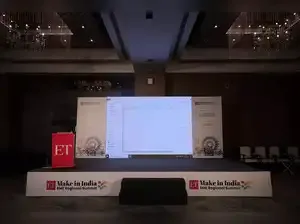The timing couldn't be better for Surat's industrial renaissance. As geopolitical tensions reshape global supply chains and AI overhauls manufacturing, this city's diverse MSME ecosystem is positioning itself to capture opportunities worth tens of billions of dollars.
The transformation is most visible in Surat's diamond district, where Jayanti Savaliya of the Gem & Jewellery Export Promotion Council (GJEPC) oversees an industry that has evolved from manual processes to AI-driven precision in just two decades.
"Changes that took a decade earlier are now happening in two years," Savaliya shared, describing how robotic machines now handle diamond sorting while AI reduces jewellery design rendering from days to minutes. Savaliya was part of the panel ‘From looms to labs: How Surat’s MSMEs can lead India’s next wave of industrial innovation’. The discussion was one of several insightful conversations at the ET Make in India SME Regional Summit in Surat, which took place on July 18. The summit had IDBI as banking and lending partner and Canon as tech enabler.
The other panellists were: Ashish Gujrati, Managing Director, Aditya Textile Solutions and Past President, SGCCI; Bikash Chandra Naik, Zonal Head, NSIC; and Prashant Patel, Past President of FISME and Director, RK Synthesis Ltd.
The Trump tariff advantage
Paradoxically, former President Trump's trade policies have become Surat's secret weapon. His tariffs hit China with 40% duties on jewellery while India faces just 16-26%, creating what Savaliya called "a huge opportunity" as manufacturing shifts from Chinese factories to Surat's 600 new jewellery facilities.
This tariff advantage extends beyond diamonds. Ashish Gujrati pointed to recent developments in Bangladesh, where a 35% tariff has global garment buyers scrambling for alternatives. Surat, which produces 65% of India's man-made fiber, stands ready to fill the gap.
The numbers are staggering: Surat's garment industry is growing 25% annually, and the city has a $30 billion export opportunity in man-made fiber textiles alone. With global MMF exports projected to grow from $7.7 billion to over $73 billion, Surat's comprehensive ecosystem — spanning the entire value chain within 45km — positions it as a natural beneficiary.
Beyond copy-paste innovation
The city's MSME transformation runs deeper than favourable trade winds. Prashant Patel, described a fundamental shift in business philosophy. "Historically, Indian companies avoided R&D, opting for copy-paste models," he noted at the ET SME Summit panel in Surat. "But since Covid-19, this mindset has changed."
Today, Surat companies invest in developing new technologies, not just new products. This includes process optimisation that reduces raw material usage and addresses pollution concerns, which are critical factors for accessing international markets increasingly focused on sustainability.
The government infrastructure supporting this innovation has evolved too. Bikash Chandra Naik spoke about NSIC’s Single Point Registration Scheme, which reserves 25% of government procurement for small businesses.
The skills premium
Surat's competitive edge increasingly lies in its skilled workforce. Despite China's scale and cost advantages, nine out of 10 diamonds globally are still processed in Surat, a testament to the city's unmatched expertise in precision manufacturing.
This advantage is expanding beyond traditional sectors. While Jaipur currently dominates gemstone processing, Savaliya underlined the untapped potential for Surat to leverage its existing infrastructure and skilled labour in this adjacent market.
Scaling challenges
Yet, obstacles remain. Land costs in Surat now exceed those in competing industrial centers like Bharuch and Vapi. Skilled workers command premium salaries that stretch MSME budgets, while the lack of shared R&D infrastructure forces companies to either invest crores of rupees in equipment or relocate to areas with better common facilities.
These challenges haven't dampened ambitions. With the PM MITRA textile park awaiting implementation and India's global textile trade share poised for recovery from its current 2.94%, Surat's MSME ecosystem appears ready to capitalise on a convergence of technological advancement and geopolitical opportunity.
As the panel discussion at the ET Make in India SME Regional Summit - Surat revealed, the city’s transformation from a traditional manufacturing hub to an innovation-driven ecosystem reflects a broader shift in Indian industry, one where MSMEs aren't just adapting to global changes, but actively shaping them.
In a world where supply chains are being redrawn and AI is redefining manufacturing, Surat's diverse industrial base and rapid technology adoption may well position it to lead India's next wave of industrial innovation.
The ET Make in India SME Regional Summits, ET MSME Day, and ET MSME Awards are flagship initiatives to celebrate the versatility and success of India’s MSME sector. If you lead or are part of a micro, small, or medium enterprise, register for the ET MSME Awards 2025 before August 31, 2025.
The transformation is most visible in Surat's diamond district, where Jayanti Savaliya of the Gem & Jewellery Export Promotion Council (GJEPC) oversees an industry that has evolved from manual processes to AI-driven precision in just two decades.
"Changes that took a decade earlier are now happening in two years," Savaliya shared, describing how robotic machines now handle diamond sorting while AI reduces jewellery design rendering from days to minutes. Savaliya was part of the panel ‘From looms to labs: How Surat’s MSMEs can lead India’s next wave of industrial innovation’. The discussion was one of several insightful conversations at the ET Make in India SME Regional Summit in Surat, which took place on July 18. The summit had IDBI as banking and lending partner and Canon as tech enabler.
The other panellists were: Ashish Gujrati, Managing Director, Aditya Textile Solutions and Past President, SGCCI; Bikash Chandra Naik, Zonal Head, NSIC; and Prashant Patel, Past President of FISME and Director, RK Synthesis Ltd.
The Trump tariff advantage
Paradoxically, former President Trump's trade policies have become Surat's secret weapon. His tariffs hit China with 40% duties on jewellery while India faces just 16-26%, creating what Savaliya called "a huge opportunity" as manufacturing shifts from Chinese factories to Surat's 600 new jewellery facilities.
This tariff advantage extends beyond diamonds. Ashish Gujrati pointed to recent developments in Bangladesh, where a 35% tariff has global garment buyers scrambling for alternatives. Surat, which produces 65% of India's man-made fiber, stands ready to fill the gap.
The numbers are staggering: Surat's garment industry is growing 25% annually, and the city has a $30 billion export opportunity in man-made fiber textiles alone. With global MMF exports projected to grow from $7.7 billion to over $73 billion, Surat's comprehensive ecosystem — spanning the entire value chain within 45km — positions it as a natural beneficiary.
Beyond copy-paste innovation
The city's MSME transformation runs deeper than favourable trade winds. Prashant Patel, described a fundamental shift in business philosophy. "Historically, Indian companies avoided R&D, opting for copy-paste models," he noted at the ET SME Summit panel in Surat. "But since Covid-19, this mindset has changed."
Today, Surat companies invest in developing new technologies, not just new products. This includes process optimisation that reduces raw material usage and addresses pollution concerns, which are critical factors for accessing international markets increasingly focused on sustainability.
The government infrastructure supporting this innovation has evolved too. Bikash Chandra Naik spoke about NSIC’s Single Point Registration Scheme, which reserves 25% of government procurement for small businesses.
The skills premium
Surat's competitive edge increasingly lies in its skilled workforce. Despite China's scale and cost advantages, nine out of 10 diamonds globally are still processed in Surat, a testament to the city's unmatched expertise in precision manufacturing.
This advantage is expanding beyond traditional sectors. While Jaipur currently dominates gemstone processing, Savaliya underlined the untapped potential for Surat to leverage its existing infrastructure and skilled labour in this adjacent market.
Scaling challenges
Yet, obstacles remain. Land costs in Surat now exceed those in competing industrial centers like Bharuch and Vapi. Skilled workers command premium salaries that stretch MSME budgets, while the lack of shared R&D infrastructure forces companies to either invest crores of rupees in equipment or relocate to areas with better common facilities.
These challenges haven't dampened ambitions. With the PM MITRA textile park awaiting implementation and India's global textile trade share poised for recovery from its current 2.94%, Surat's MSME ecosystem appears ready to capitalise on a convergence of technological advancement and geopolitical opportunity.
As the panel discussion at the ET Make in India SME Regional Summit - Surat revealed, the city’s transformation from a traditional manufacturing hub to an innovation-driven ecosystem reflects a broader shift in Indian industry, one where MSMEs aren't just adapting to global changes, but actively shaping them.
In a world where supply chains are being redrawn and AI is redefining manufacturing, Surat's diverse industrial base and rapid technology adoption may well position it to lead India's next wave of industrial innovation.
The ET Make in India SME Regional Summits, ET MSME Day, and ET MSME Awards are flagship initiatives to celebrate the versatility and success of India’s MSME sector. If you lead or are part of a micro, small, or medium enterprise, register for the ET MSME Awards 2025 before August 31, 2025.





